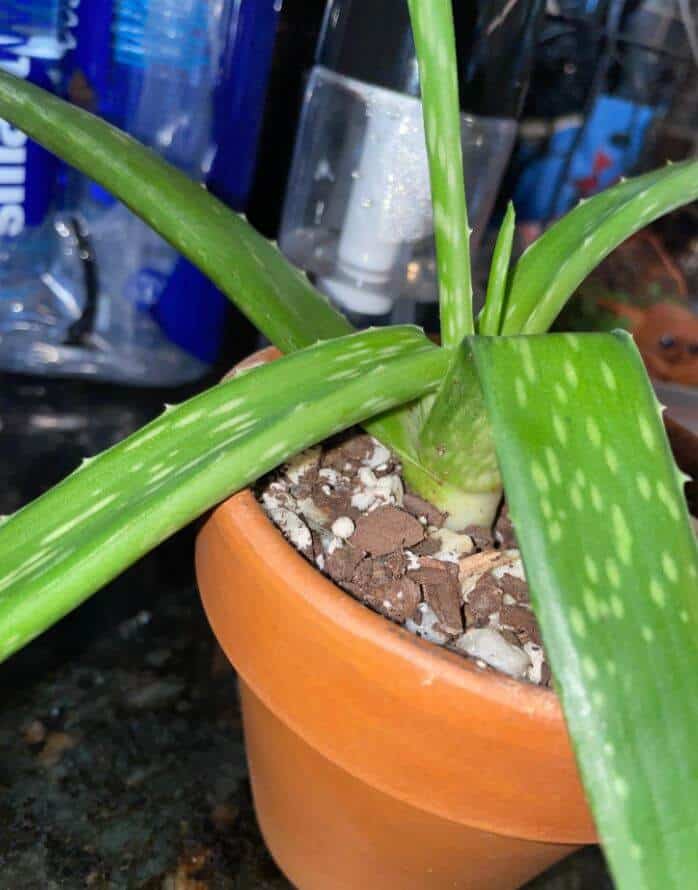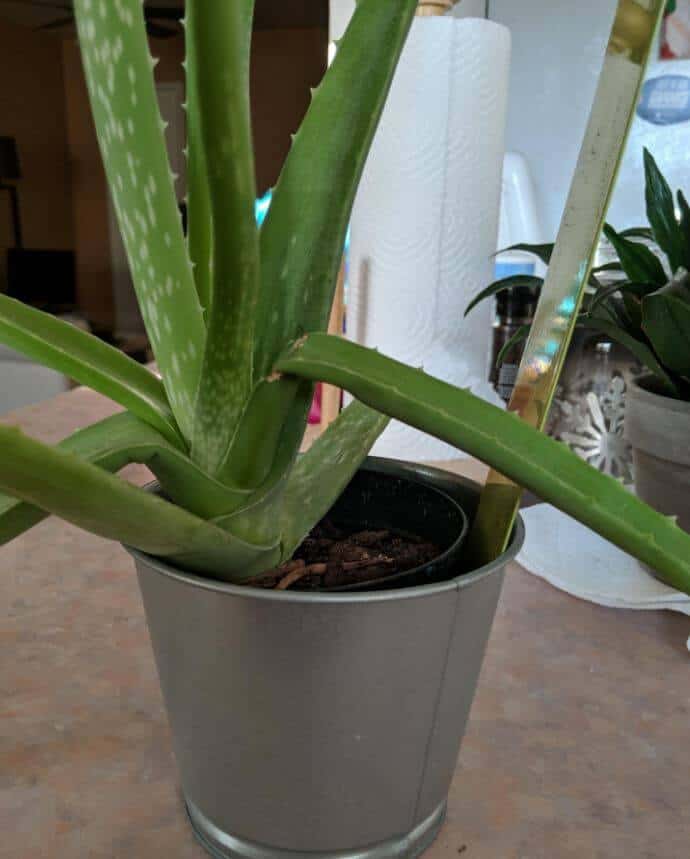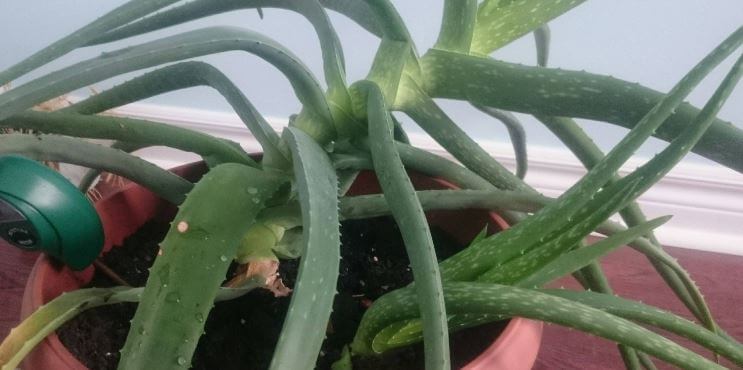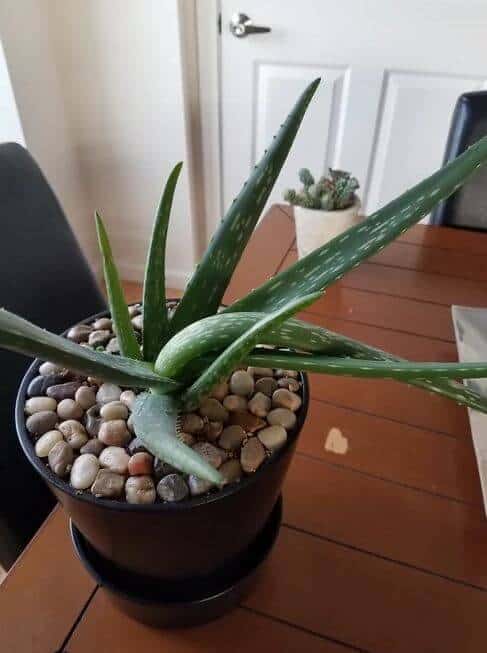Last Updated on January 5, 2023 by a Friendly Gardener
If an aloe vera plant’s leaves begin to bend, it’s an indication that your plant has a problem. This problem can be so severe that if left unaddressed your plant may die. Unfortunately, there is more than one reason that aloe vera plant leaves bend, so a bit of investigation is called for.
Reasons may include bacterial infections, fungal infections, overwatering, pest attacks, and even poor drainage. The most common reason may be a watering problem, but you must identify the cause for leaves bending to save your aloe vera.
Why Is My Aloe Vera Plant Leaf Bent?

Internal issues will weaken an aloe vera plant and leaves will begin to bend along with other symptoms like yellowing leaves and brown leaf tips. Here are some of the most common causes for
aloe vera leaves bending and what to do about each cause.
Bacterial Infection
A closer look at aloe vera leaves can indicate a bacterial attack. Foliage will appear swallowed and turn dark in color. This infection is more common in younger aloe vera plants and will spread through a plant very rapidly making it at risk for serious consequences.
An Aloe vera plant will be able to survive a bacterial attack if it is a mild one. Keeping your plant’s environment clean with good air ventilation. Warmer temperatures, higher humidity, and overwatering can increase the risk of a bacterial attack.
Cold Environmental Temperatures
Aloe vera is a succulent and requires a warm climate. If environmental temperatures drop below 55°F. your aloe vera will suffer. Plant leaves may bend to communicate their health status and that it is unwell.
Attempt to keep your plant’s environmental temperature between 65° and 85°F. If temperatures are on the higher side, that’s okay as these succulent leaves store water.
Dry Rot Disease

Dry rot disease is serious and potentially lethal. Aloe vera foliage will be yellow and bend. The plant itself begins to dry because this fungal infection is drying out the plant’s internal tissue. Dry rot is usually the result of overwatering or pest infestations.
Sadly, if a plant gets infected, it cannot be saved. You will need to destroy it especially if you have other plants in the same area. Correct watering and sunlight together with occasional feeding will help prevent this disease.
Should your plant become infected, do not reuse the plant’s container for other plants, because traces of this fungal disease can remain on the surface. To avoid problems, toss the container.
Improper Container Characteristics or Size
The plant’s pot needs to have sufficient drainage holes. If drainage is inadequate, leaves will begin to droop and bend because the soil is waterlogged. Soggy soil will pressure the root ball and can impede a fresh supply of oxygen from reaching the root system. This will also prevent the plant from absorbing adequate nutrients and moisture. It can also contribute to the risk of root rot.
If the container hosting your Aloe vera plant is too small, the root system will be cramped and unable to grow and develop correctly. The Aloe root system requires ample space for healthy growth.
When cultivating an aloe vera use a larger-sized container with adequate drainage holes to provide some space between the roots and the sides and bottom of the pot. To guarantee that some space remains between the pot and the root system, place a layer of pebbles on the pot’s bottom before adding in the soil mixture.
Inadequate Light
Aloe vera needs generous sunlight to grow and maintain its health. If the necessary bright light is insufficient, the foliage will begin to bend and turn yellow. With too little light, your aloe vera will not be able to produce adequate chlorophyll which in turn negatively affects the plant’s glucose level which is the plant’s source of nourishment. Without nourishment, the aloe will weaken and not be able to support the leaves’ weight, thus bending.
Move your plant to a spot with more sunlight, or if this is not possible, consider using grow lights. Never expose an aloe vera to direct sunlight for long. Direct hot sunlight can damage the foliage. The first hint will be if leaves begin to show a hint of red.
How to Fix a Bent Aloe Vera Leaf

Bent leaves cannot be revived so begin to heal your plant by removing and pruning off bent leaves. To prevent other leaves from bending follow these care tips:
Soil

Ideally, plant your aloe vera in a growing medium formulated for succulents or cacti.
Light
Aloe vera needs lots of bright indirect light for photosynthesis to produce nourishment. Direct sunlight risks burning leaves. The Aloe can be placed directly on a windowsill during morning hours. Grow lights can also be used if you do not have access to adequate bright indirect light.
Water
Allow the soil bed to dry before watering anew. The summer season may require an increase in watering. Use filtered or collected rainwater if possible as chlorine or heavy minerals in the water may compromise your plant.
Feeding
Feed your plant with a succulent fertilizer monthly during the spring and summer growing seasons.
Temperature
Place your plant in a location with an environmental temperature measuring between 65° and 85° F. Aloe vera are not frost-hardy nor do they enjoy cool drafts or cold winds.
The Bottom Line

With proper care, your Aloe Vera plant should not develop bending leaves. A growing medium formulated for succulents and cacti together with a generous indirect bright light the foundation for a healthy plant. A proper container and good watering practice with the occasional feeding will guarantee a strong, healthy, and beautiful Aloe vera plant.

